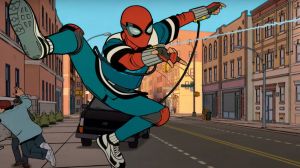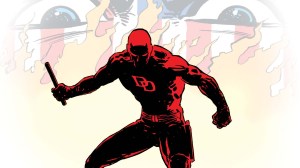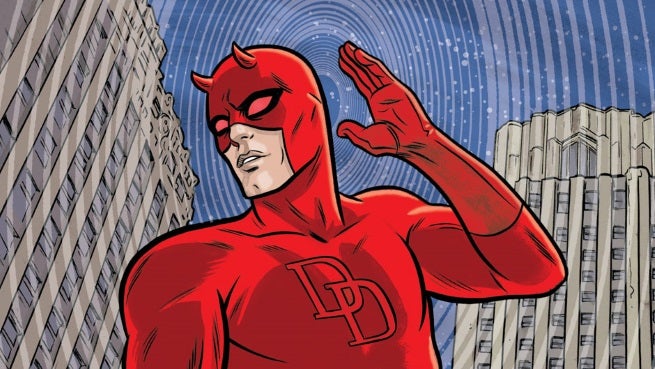
Marvel’s upcoming Daredevil Netflix series continues to take shape with the recent announcements that Rosario Dawson has been cast as a yet-to-be-named character and Elden Henson will portray Matt Murdock’s best friend and law partner Foggy Nelson. These two will join Charlie Cox (Murdock/Daredevil) and Vincent D’Onofrio (Wilson Fisk/Kingpin) on the show, which is projected to debut sometime next year.
Videos by ComicBook.com
With some of these key pieces in place, the time seems right to start speculating about storylines that are worth adapting for the series. Considering how Daredevil has been at the center of some of the most important moments in Marvel Comics history – arcs like “Born Again” by Frank Miller and David Mazzuccehlli; “The Elektra Saga,” by Miller and Klaus Janson; and “Guardian Devil” by Kevin Smith and Joe Quesada – there is seemingly a ton of quality content to cull from.
However, if the first season of Marvel’s Agents of S.H.I.E.L.D. has taught us anything, it’s that Marvel tends to think a tad smaller with its television output, which means the budget may not be there for something as grandiose and epic as the aforementioned stories. Is Marvel really going to burn down Hell’s Kitchen and pay Chris Evans for a cameo as Captain America in order to faithfully adapt “Born Again?” And is the company even in a position to use a Spider-Man villain like Mysterio (owned by Sony Pictures) for a “Guardian Devil” arc? Will we see “The Elektra Saga” again after the failure that was the 2004 feature film?
Fortunately, the Daredevil comic book series is also filled with quieter, character-driven moments that would translate perfectly on the small screen. These 10 stories are just a starting point for Marvel as it starts to plot out the direction of its series.
Origin Stories
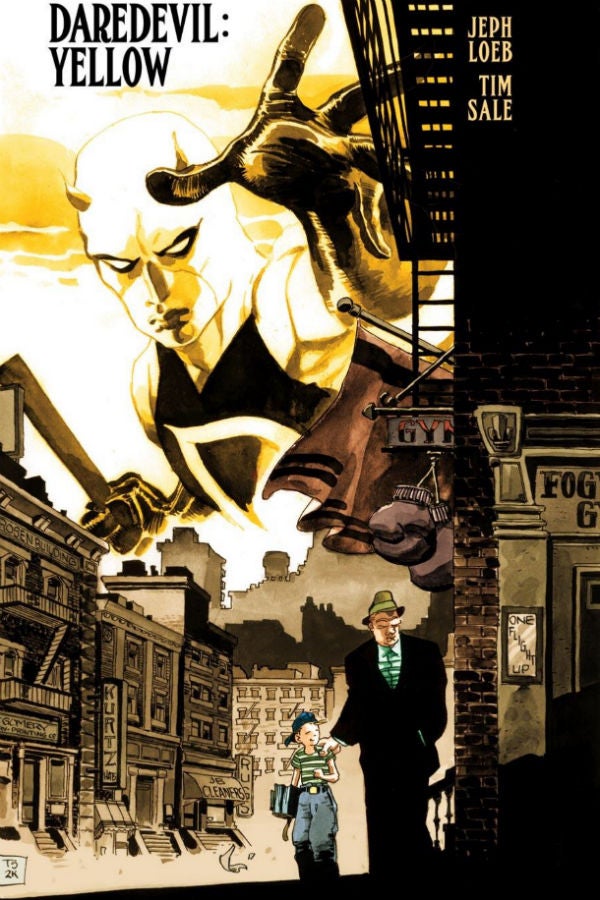
Daredevil: Yellow #1-6
Because of how successfully Frank Miller reinvented Daredevil over the course of his career, many fans of the character have unwittingly forgotten or ignored ‘Ol Hornhead’s early “yellow” days as a superhero under Stan Lee and Bill Everett. If Marvel wants to pay homage to Daredevil’s first stories in a way that’s a little more modern and accessible to contemporary fans, the initial episodes of the series could very easily follow the template put forward by the Jeph Loeb/Tim Sale miniseries Daredevil: Yellow.
Yellow is set in modern day in the wake of the death of Matt Murdock’s first love, Karen Page (which transpired during Kevin Smith’s “Guardian Devil” arc). Like some of the other Loeb/Sale Marvel miniseries released during the early 2000s like Spider-Man: Blue, Yellow is meant to be pensive and melancholy, but also wistful and celebratory. In it, the creative team examines how Murdock grew from a novice superhero into the “Man Without Fear,” all thanks to the love and admiration he secretly holds for Karen.
Beyond the way Yellow defines Karen as the true love of Matt’s life, the story also weaves in some of Daredevil’s earliest rogues like the Owl and Purple Man. Introducing these characters into the Netflix series could be an effective way to broaden Daredevil’s rogue’s gallery beyond Kingpin, Kingpin and more Kingpin.

Daredevil #1 (vol. 3)
In terms of its tone, the Daredevil series could either be steeped in the mythology and mysticism of the Frank Miller run (more on that in a second), or it could be an homage to the brighter, bouncer Silver Age era where the “Man Without Fear” was far less brooding and dark. If Marvel decides to go with the latter, but wants to steer clear of “Yellow,” it could adapt the very first issue of Mark Waid’s critically acclaimed run on the book (which is still going strong after nearly three years).
Waid’s first issue, which is illustrated by Paolo Rivera and Marcos Martin, doesn’t really rehash Daredevil’s origin as much as it provides a ton of visual and narrative clarity as to who he is and what his world is about. There’s a short and fun battle with D-list villain the Spot, but more importantly the comic is chock full of moments that demonstrate the dual life of Daredevil and Matt Murdock, without being mired in exposition.

The Man Without Fear #1-5
Frank Miller and John Romita Jr.’s 1993 reimagining of Daredevil’s origin story was initially pitched by its creators as a screenplay for a potential film. As such, it features all of the elements in terms of exposition, fan favorite characters, action and mythology, to make for an absolutely epic season of television.
In this miniseries, Miller’s script manages to pay its respects to the original Stan Lee/Bill Everett tale of Matt Murdock/Daredevil, while also working in characters and plot-points from his own critically-acclaimed run on Daredevil in the late 1970s/early 1980s. That includes scenes of Daredevil getting trained as a young man by the mystical Stick, his college romance with the future femme fatale Elektra, and the rise of Wilson Fisk, aka the Kingpin of crime.
In the years since it was published, The Man Without Fear has been deemed the definitive take on Daredevil’s earliest days. With Marvel likely aiming to draw in casual fans of its comics through these Netflix series, this mini is the most logical way to produce an origin story on television that doesn’t come across as too plodding or dated.
Standalone Stories
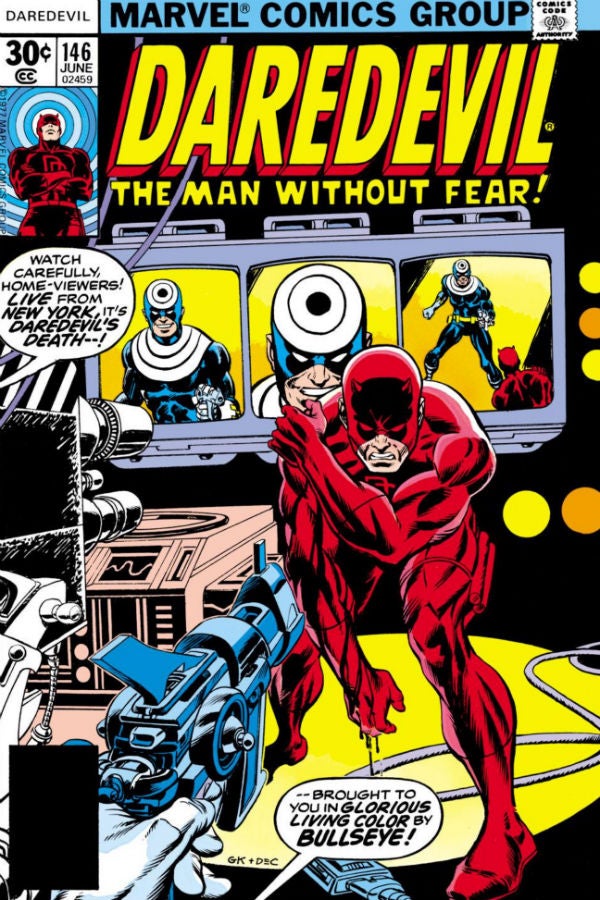
Duel (Daredevil #146)
After introducing Bullseye (who would go on to be one of Daredevil’s primary adversaries) a handful of issues earlier, the creative team of Jim Shooter and Gil Kane delivered this 1977 story that is highlighted by a Daredevil/Bullseye battle in a television studio.
Despite the fact that Daredevil will appear on a subscriber-based streaming media service, it will be interesting to see how Bullseye is potentially presented in the series. During the Frank Miller run on Daredevil, Bullseye, the villain who “never misses,” was characterized as a cold-blooded sociopath who kills indiscriminately. As such, his presence could possibly turn off more casual viewers of the Netflix series.
“Duel” shows a kindler/gentler (but still criminal) version of Bullseye. He is first confronted by Daredevil after he is caught robbing a jewelry store – a far cry from the time he murdered some nuns in a church or bragged about killing a child with a popsicle stick. Viewers might gravitate more towards this toned-down version of the villain, who is still capable of being incredibly inventive using weapons as deadly projectiles.

Brother, Take My Hand! (Daredevil #47)
The quintessential “one and done” story, the Daredevil team could adapt this 1968 story by Stan Lee and Gene Colan and put forward a solid, hour-long, character-driven episode. The issue introduces the world to William Lincoln, a former cop who was blinded while serving a tour of duty in Vietnam. When Daredevil visits the troops overseas, he meets Lincoln, who tells him he’s a former cop who’s been wrongly accused of taking bribes from a mobster. Daredevil sets him up with an attorney, Matt Murdock, who eventually clears his name and gets Lincoln his job back.
“Brother, Take My Hand!” would work perfectly as a standalone episode used as a cooldown at the conclusion of a tense multi-episode arc, and as a precursor to the season’s next major story. The bulk of the episode can take place inside a courtroom, with some occasional flashback sequences as Lincoln tells his story.

The Great Divide (Daredevil #17, vol. 3)
Perhaps no writer has approached the “bromance” of law partners Matt Murdock and Foggy Nelson better than Mark Waid. And no story is as good of a demonstration of the rich emotional potential of this friendship as “The Great Divide.” In this issue, Matt – via a flashback – recalls a time that Foggy arranges for an experimental surgery that will restore his eyesight for 30 minutes. Once Matt can see again, Foggy produces a video of his friend’s deceased father, Battlin’ Jack Murdock’s title-winning boxing fight – the victory that would eventually lead to his murder at the hands of the mob.
The scene where Matt gets to witness this pivotal personal event is incredibly touching, and really drives home the brotherly love between Murdock and Nelson. While Foggy has sometimes been portrayed as a bit of a self-centered goofball, Waid clearly understands that the Daredevil universe is an infinitely more enjoyable place when all of the characters are provided with depth and complexity.
Similar to “Brother, My Hand,” “The Great Divide” would ideally function as a standalone episode between arcs. It would also need to come with a “get a box of tissues” warning, for the heartwarming conclusion.

My Story (Daredevil #179)
Frank Miller’s contributions to Daredevil are endless – integrating Kingpin into the series and making him Matt Murdock’s chief nemesis; creating characters such as Elektra and Stick – but one of the writer/artist’s greatest achievements during his initial late 1970s/early 80s run was how he utilized the chain smoking Daily Bugle reporter Ben Urich.
Prior to Miller’s characterization of Urich, the Marvel’s depiction of the fourth estate consisted mainly of over-the-top personalities, most notably Bugle editor/publisher J. Jonah Jameson. But with Urich, Miller took this rank-and-file reporter and turned him into a blue collar reporter, capable of using his keen intellect and persistence to break any story about the criminal underworld.
In the midst of the famed “Elektra Saga,” Miller had the wherewithal to focus one issue almost entirely from Urich’s perspective. Titled “My Story,” the comic follows Urich as he’s trying to prove there’s a connection between the Kingpin, and mayoral candidate Randolph Cherryh. The story reads like a love story to newspaper reporting – as Urich shares little tricks of the trade like, “if it’s not supposed to be there, it’s a lead,” or “when in doubt, take a picture.”
Naturally, Urich gets too close to the truth, and Elektra is dispatched – first to kill an informant while he’s talking to Ben in a movie theater. She later flings a sai at Urich as he’s spying on her confrontation with Daredevil.
Hopefully, whatever role Urich plays in this latest iteration of Daredevil reflects this very rich and dynamic character that Miller breathed new life into. Similar to Daredevil #179, depicting Urich’s perspective for select sequences on the small screen adaptation could prove to be very riveting television.
Multi-Episode Arcs

Parts of a Hole (Daredevil #9-15, vol. 2)
While initial speculation dictates that Rosario Dawson has been cast to play Daredevil’s former love interest-turned-adversary, Elektra, don’t sleep on the possibility of her portraying Maya Lopez, the deaf heroine who is also known as Echo.
In this David Mack/David Ross storyline – which was sandwiched between Kevin Smith’s famed “Guardian Devil” arc and the beginning of the Brian Michael Bendis/Alex Maleex run – Lopez is deceived by the Kingpin into thinking that Daredevil killed her father. Despite being deaf, Lopez is capable of perfectly imitating any fighting style she studies – hence the “echo” moniker. As a result, when she sets out on her path of vengeance against Daredevil, the “Man Without Fear” takes quite a beating from the woman he’s otherwise very fond of in their civilian identities.
Featuring Echo would offer Daredevil viewers a less obvious variation on the romance/femme fatale dynamic Daredevil has with many of the women in his life. Plus the storyline shows the Kingpin doing what he does best – wreaking havoc on Matt Murdock’s life from behind-the-scenes.

Underboss (Daredevil #26-31, vol. 2)
Considering the global success of HBO’s mob/crime drama The Sopranos during the late 90s/early 2000s – the show that arguably changed the medium forever – Marvel would be wise to consider the inaugural arc of the critically acclaimed Brian Michael Bendis/Alex Maleev Daredevil run for a potential adaptation. While Wilson Fisk, aka the Kingpin, had been a critical part of the Daredevil universe for more than 20 years before “Underboss” was published, the Bendis/Maleev story took a considerably deeper look at the political machinations of Marvel’s fictionalized New York City underworld in order to shape a universe that was both sophisticated and funny.
One of the chief creations of the “Underboss” arc was the sleazy wannabe tough guy Sammy Silke, who orchestrates a Julius Caesar-esque coup against the Kingpin, as a result of Fisk’s reluctance to make a move against Daredevil’s civilian alter ego Matt Murdock. Silke, who comes across as entitled and petulant, is the perfect criminal foil to Kingpin’s methodical, chess-playing personality.
Additionally, “Underboss” presents a vivid picture of the unique and complicated dynamic between Fisk and Murdock. They both have been playing a game of cat-and-mouse for years, with Fisk having attempted to destroy Matt/Daredevil on multiple occasions. But there’s also an understanding that on some level, the two need each other (as Kingpin and Daredevil respectively) in order to thrive as Fisk and Murdock. By borrowing character elements from this story, the Daredevil series would demonstrate that there’s more to the Kingpin and Daredevil than just a battle of “good” versus “evil.”

Out (Daredevil #32-40)
Ideally, Daredevil’s first season on Netflix will be such a smashing success that creators will be clamoring for a nice, long-form arc to adapt for the show’s second season. Enter the 2002 storyline “Out,” which deals with the ramifications of adesperate wiseguy, Sammy Silke, outing Daredevil’s civilian identity to the cops (who in turn leak it to The Globe tabloid). Matt Murdock becomes the worst kind of media sensation, with the press camping out in front of his home and watching his every move in hopes of confirming his secret life as Daredevil.
“Out” is extremely character driven, and features a number of Daredevil’s friends and superhero allies coming to his aid. The only real supervillain that shows up is a brief cameo by Mr. Hyde. So not only is “Out” considered one of the better Brian Michael Bendis stories, but it can be replicated on a modest budget to boot.
The storyline also dovetails nicely with the tragic “The Trial of the Century storyline. In it, Murdock agrees to represent Hector Ayala, aka the White Tiger, who has been wrongly accused of a murder of a police officer. Despite their being scant evidence, Ayala is convicted due to the jury’s dislike of costumed vigilantes. After he is convicted, Ayala attempts to escape the courthouse where he is gunned down by police.
Part of what makes Daredevil such an interesting comic to adapt for television is how it combines superhero action with courtroom drama. Considering how some of the more popular serial dramas on TV are based in courtrooms (cue the “chung chung” now), “Out” and “Trial of the Century” could make for some extraordinarily accessible stories for viewers.


